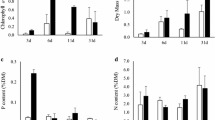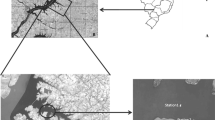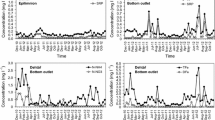Abstract
The potential of periphyton-based aquaculture in South Asia is under investigation in an extensive research program. This paper is a further analysis of data from four experiments carried out in that framework, to explore periphyton, fish and fertilizer dose effects on water quality. Factor analysis and ANOVA models applied to a data matrix of water quality parameters in ponds with and without artificial substrates (bamboo poles and kanchi sticks), with and without fish (filter feeders catla and rohu, with and without bottom feeder kalbaush), and with a standard or 50% increased fertilizer dose, allowed us to identify the underlying ecological processes governing this novel periphyton-based pond system, and construct conceptual graphic models of the periphyton–environment relationships observed. We clearly established that the phosphorus flow is mainly linked to phytoplankton activity in the water column and decomposition on the pond bottom, while nitrogen flow is mainly linked to autotrophic (photosynthesis) and heterotrophic (decomposition and nitrification) processes that take place in the periphyton in addition to the water column and pond bottom. Consequently, disruption of the pond bottom by bottom feeding fish primarily promoted phosphate cycling and phytoplankton, while periphyton development on the supplied substrates and fertilization mainly improved oxygen balance and nitrogen related processes developing in the water column. The use of bamboo poles led to better results than kanchi sticks, related to the greater autotrophic periphyton development on bamboo and to the larger surface of bamboo poles that facilitate fish grazing and periphyton dislodgment that in turn have a renewal effect on periphyton. Stocking bottom feeding fish produces a fertilizing effect through the food web that benefits the filter-feeding fish and that makes it unnecessary to increase the dose of inorganic and organic fertilizers applied to the ponds. Thus, the output of this analysis will help the fish farmers in resource constrained countries to improve their production in periphyton-based ponds just by choosing bamboo substrates, stocking a bottom feeder fish together with the filter feeders, and saving money on fertilizers.
Similar content being viewed by others
References
Ahmed, Z.F. 1993. Electivity index and dietary overlap of Catla catla Hamilton in fertilized and fed and fertilized ponds of Bangladesh. M.Sc. thesis, Faculty of Fisheries, BAU, Mymensingh. 163 pp.
Azim, M.E. 2001. The potential of periphyton-based aquaculture production systems. Ph.D. Dissertation. Fish Culture and Fisheries Group, Wageningen University, the Netherlands. 219 pp.
Azim, M.E., M.A. Wahab, A.A. van Dam, M.C.M. Beveridge, A. Milstein & M.C.J. Verdegem. 2001a. Optimization of fertilization rate for maximizing periphyton production on artificial substrates and the implications for periphyton-based aquaculture. Aquacult. Res. 32: 749-760.
Azim, M.E., M.A. Wahab, A.A. van Dam, M.C.M. Beveridge & M.C.J. Verdegem. 2001b. The potential of periphyton-based culture of two Indian major carps, rohu Labeo rohita (Hamilton) and gonia Labeo gonius (Linnaeus). Aquacult. Res. 32: 209-216.
Azim, M.E., M.C.M. Verdegem, H. Khatoon, M.A. Wahab, A.A. van Dam & M.C.M. Beveridge. 2002a. A comparison of fertilization, feeding and three periphyton substrates for increasing fish production in freshwater pond aquaculture in Bangladesh. Aquaculture 212: 227-243.
Azim, M.E., M.C.J. Verdegem, M.M. Rahman, M.A. Wahab, A.A. van Dam. & M.C.M. Beveridge. 2002b. Evaluation of polyculture of Indian major carps in periphyton-based ponds. Aquaculture 213: 131-149.
Azim, M.E., M.A. Wahab, A.A. van Dam, J.M. van Rooij, M.C.M. Beveridge & M.C.J. Verdegem. 2002c. The effects of artificial substrates on freshwater pond productivity and water quality and the implications for periphyton-based aquaculture. Aquat. Living Resour. 15: 231-241.
Azim, M.E., A. Milstein, M.A. Wahab & M.C.J. Verdegam. 2003. Periphyton-water quality relationships in fertilized fishponds with artificial substrates. Aquaculture (in press).
Boyd, C.E. 1979. Water Quality in Warmwater Fish Ponds, Auburn University, Alabama, U.S.A. 359 pp.
Boyd, C.E., 1994. Water Quality in Ponds for Aquaculture, Auburn University, Alabama, U.S.A. 482 pp.
Bratvold, D. & C.L. Browdy. 2001. Effect of sand sediment and vertical surfaces (AquaMats™) on production, water quality and microbial ecology in an intensive Litopenaeus vannamei culture system. Aquaculture 195: 81-94.
Das, S.K. & S.K. Moitra. 1955. Studies on the food of some common fishes of Uttar Pradesh. Proc. Natl Acad. Sci. India 25b: 1-6.
Dempster, P.W., M.C.M. Beveridge & D.J. Baird. 1993. Herbivory in tilapia Oreochromis niloticus: A comparison on phytoplankton and periphyton. J. Fish Biol. 43: 385-392.
Dewan, S., M.A. Wahab, M.C.M. Beveridge, M.H. Rahman & B.K. Sarkar. 1991. Food selection, electivity and dietary overlap among planktivorous Chinese and Indian major carp fry and fingerlings grown in extensively managed, rain-fed ponds in Bangladesh. Aquacult. Fish. Manag. 22: 277-294.
Hansson, L.A. 1989. The influence of a periphytic biolayer on phosphorous exchange between substrate and water. Archiv. Hydrobiol. 115: 21-26.
Hargreaves, J.A. 1998. Nitrogen biogeochemistry of aquaculture ponds. Aquaculture 166: 181-212.
Jeffers, J.N.R. 1978. An Introduction to Systems Analysis: With Ecological Applications, Edward Arnold, London.
Keshavanath, P., B. Gangadhar, T.J. Ramesh, A.A. van Dam, M.C.M. Beveridge & M.C.J. Verdegem. 2002. The effect of periphyton and supplemental feeding on the production of the indigenous carps Tor Khudree and Labeo fimbriatus. Aquaculture 213: 207-218.
Kim, J.O. & C.W. Mueller. 1978. Factor Analysis. Statistical Methods and Practical Issues. Quantitative applications in the Social Sciences 14, Sage University.
Kumar, F. & M.S. Siddiqui. 1989. Food and feeding habits of the carp Labeo calbasu Ham. in north Indianwaters. Acta Ichthyol. Piscatoria 19(1): 33-48.
Milstein, A. 1992. Ecological aspects of fish species interactions in polyculture ponds. Hydrobiologia 231: 177-186
Milstein, A. 1993. Factor and cannonical correlation analyses: Basic concepts, data requirements and recommended procedures. pp. 24-31. In: M. Prein, G. Hulata & D. Pauly (ed.) Multivariate Methods in Aquaculture Research: Case Studies of Tilapias in Experimental and Commercial Systems, ICLARM Stud. Rev. 20.
Milstein, A., M.A.Wahab & M.M. Rahman. 2002. Environmental effects of common carp Cyprinus carpio (L.) and mrigal Cirrhinus mrigala (Hamilton) as bottom feeders in major Indian carp polycultures. Aquacult. Res. 33: 1103-1117.
NFEP 1997. Production enhancement of the Indian major carp, Labeo rohita (Ham.) using bamboo trimmings as a substrate for the growth of periphyton, NFEP Paper No. 10, Northwest Fisheries Extension Project, Parbatipur, Dinajpur, Bangladesh.
Prein, M. & A. Milstein. 1988. Techniques for handling large pond and farm datasets. Aquabyte 1: 4-5.
Ramesh, M.R., K.M. Shankar, C.V. Mohan, & T.J. Varghese. 1999. Comparison of three plant substrates for enhancing carp growth through bacterial biofilm. Aquacult. Eng. 19: 119-131.
Schroeder, G.L., A. Alkon & M. Laher. 1991. Nutrient flow in pond aquaculture systems. pp. 489-505. In: D.E. Brune & J.R. Tomasso (ed.) Aquaculture and Water Quality, World Aquaculture Society. Baton Rouge, LA.
Seal, H.L. 1964. Multivariate Statistical Analysis for Biologists, Methuen, London.
Thompson, F.L., P.C. Abreu & W. Wasielesky. 2002. Importance of biofilm forwater quality and nourishment in intensive shrimp culture. Aquaculture 203: 263-278.
van Dam, A.A., M.C.M. Beveridge, M.E. Azim & M.C.J. Verdegem. 2002. The potential of fish production based on periphyton. Rev. Fish Biol. Fish. 12: 1-31.
Wahab, M.A., M.E. Azim, M.H. Ali, M.C.M. Beveridge & S. Khan. 1999. The potential of periphyton-based culture of the native major carp kalbaush, Labeo calbasu (Hamilton). Aquacult. Res. 30: 409-419.
Author information
Authors and Affiliations
Rights and permissions
About this article
Cite this article
Milstein, A., Azim, M.E., Abdul Wahab, M. et al. The Effects of Periphyton, Fish and Fertilizer Dose on Biological Processes Affecting Water Quality in Earthen Fish Ponds. Environmental Biology of Fishes 68, 247–260 (2003). https://doi.org/10.1023/A:1027344417528
Issue Date:
DOI: https://doi.org/10.1023/A:1027344417528




